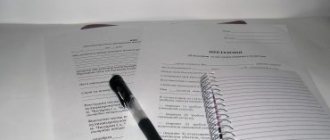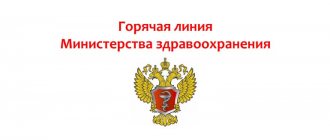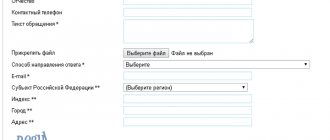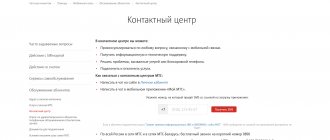Etiquette and literacy
Never forget about politeness. As already emphasized above, it is important if you are interested in business correspondence
Phrases like “glad to cooperate”, “thank you for your attention”, “I apologize for disturbing you”, “we will be glad to see you”, “would you like to join us” and others. The last two, by the way, refer more likely to invitations to corporate celebrations than to a business letter
Always, as a sign of respect, add “please,” “thank you,” “would you be kind,” etc. to phrases where appropriate.
Human literacy is no less important in the process of writing business letters. More precisely, if you make even one elementary mistake in the process of creating a letter, we can say that the interlocutor will form a completely different opinion about you than the one you expect
Therefore, try to write as competently as possible and check everything several times. If you don’t know how to find errors and correct them yourself, use the services of a proofreader or specialized services. It's very simple, but it will allow you to be confident in your text.
Letter requirements
So, the rules of business correspondence state that all letters must, firstly, be brief. This is the main rule that it will be read. Agree, we all don’t like when we are loaded with a large amount of information. If this is a business letter, it should not be huge - in this case, it may simply be ignored. If you can’t shorten the information right away, do it after you write the first draft of your letter.
Secondly, your partner (participant in the correspondence) must understand what is being said. That is, the letter should be made informative and understandable. It should contain the information that you would like to convey in such a way as to avoid additional questions and not waste time on clarifying details.
Thirdly, the letter should be made as respectful as possible towards your partner or company employee who will read it. It's true - the more respect you show your interlocutor, the more likely it is that he will respond appropriately to your request and, in the end, you will achieve the desired effect.
Common and uncommon requests
As follows from the definition, an appeal can be expressed in one or several words, that is, it can be uncommon and widespread, for example:
Congratulations, man! Congratulations, Earth! (R. Rozhdestvensky).
Why are you bowing your crown over the waters, O willow? (S. Yesenin).
My dear, how beautiful (I.A. Krylov).
Sing to us, wind, about wild mountains, about the deep secrets of the seas (V. Lebedev-Kumach).
Where are you, bright stream, heading? (I.A. Krylov).
Forget, my dear comrade, discord is funny and useless (A.S. Pushkin).
Are you my fallen maple, icy maple, why are you standing bent over under the white snowstorm? (S. Yesenin)
Hello, light stars of the fluffy first snow! (I. Turgenev).
I give all my sonorous power as a poet to you, attacking class (V.V. Mayakovsky).
How I loved, my majestic Caucasus, your sons’ warlike morals (M. Lermontov).
If parts of a common address are separated by other members of the sentence, then each part is separated by commas:
Why, smart one, are you delirious, head? (I. A. Krylov).
Personal pronouns “you”, “you”, as a rule, are subjects in a sentence, but can be part of a common address. Let's compare:
You, prince, are my savior, my mighty deliverer (A.S. Pushkin)
Hello, my handsome prince! (A.S. Pushkin).

How to understand abbreviations
- EOB (end of business day) → end of the working day.
- SOB (start of business day) → the beginning of the working day.
- EOQ (end of quarter) → by the end of the quarter.
- TBD (to be determined) or TBA (to be announced), we use it when information on the timing or date is not yet known.
- PTO (paid time off) → vacation.
- OOO (Out of office) → outside the office, not at work. The phrase is used in auto replies.
- FUP (follow up) → follow, take control.
- POC (point of contact) → contact person.
- FYI (for your information) → for your information.
- AAMOF (As A Matter Of Fact) → essentially.
- AFAIK (As far as I know) → as far as I know.
- BTW (By The Way) →by the way.
- CU (see you) → see you
- F2F (face to face) → alone.
- IMHO (In My Humble (Honest) Opinion) → in my humble opinion.
How to write a business letter
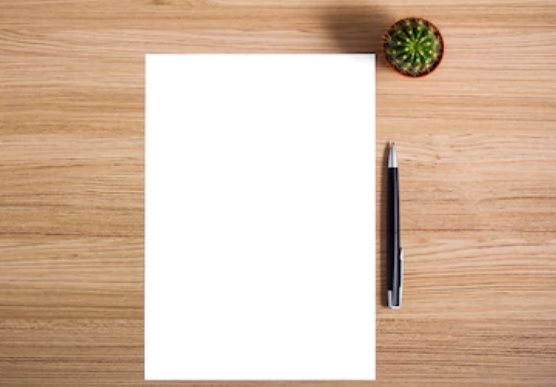
There are certain rules and regulations for writing a business letter. The main aspect is compliance with business etiquette. Business correspondence is a type of official correspondence.
There are several types of business correspondence, namely:
- circular letters - inform subordinates of any information or instructions;
- letters of inquiry - requests to formulate a commercial proposal or describe a product/service;
- letters of guarantee - sent to confirm the terms of contracts;
- complaint (claim);
- cover letters, etc.
But all types of business letters have the same differences from a simple letter.
Main differences:
- Writing style. It implies brevity and capacity of the letter, it is advised not to write more than one page, with the generally accepted structure of the letter, without “water”.
- Official vocabulary. Strong expressions of emotions and feelings are not allowed.
- Forms on company letterhead with details and all contact information.
- Font. Not large, but not small either. Identical throughout the entire length of the letter.
- Respect for subordination.
- Style. Your letter should be in a formal business style, i.e. use of official vocabulary.
- Relevance of information. The information in the letter must be relevant and relevant at the time of sending.
Writing a business letter on paper
Address the recipient of the letter by position/last name/first name and patronymic or generalized in the upper right corner. The subject of the letter (may sometimes be omitted). In order to correctly compose a topic, you need to think through the text of the letter and identify the main words, which then need to be summarized. You can also forward the subject of the email if it was a response to a received email. Addresses from the words Dear First Name Patronymic. The main part of the letter. Description of the problem or purpose of the letter, contains the main information, important proposals, necessary requirements, request or orders. This part contains a strictly chronological presentation of facts and logical justification.
Each paragraph contains one aspect of information. If you need to pay special attention to something in the text of the letter, then use the mark “Important!”, after which information that is important for the recipient is implied.
Example of introduction and main part:
General Director of StroyMedProm LLC Kazantsev V.O. From Yarygin P.N. st. Lesnaya 33, G
Perm (There may also be information elements of the organization) (topic) On fulfillment of the terms of the contract
Dear Viktor Olegovich! (Main part) In accordance with the recent agreement, you need to send all the documents of our agreement... Important! Documents must be certified by a notary.
- Any type of business letter must contain a conclusion, which consists of conclusions, proposals, agreements/refusals, warnings. For example, these: we ask, we remind, we warn.
- Closing phrases should encourage further cooperation or possible refusal. A postscript “PS” may appear at the end to add to the completed letter.
- If documents are attached to the letter, this should be indicated in the lower left corner of the sheet. According to business etiquette, a response to a letter should not take more than 10 days; if the response requires more time, you must inform the addressee about this.
- Also at the end there is a signature with a transcript and a date. Conclusion example:
| In connection with the above, we warn you that there are deadlines in this matter. We look forward to further cooperation! Appendix 1 “Document-agreement” Appendix 2 “Contract Agreement” Deputy Director P.N. Yarygin (signature) 25.07.2018 |
Business correspondence by E-mail
It often happens that a letter needs to be sent online. With this type of letter, you should also follow the rules and not forget about the official style.
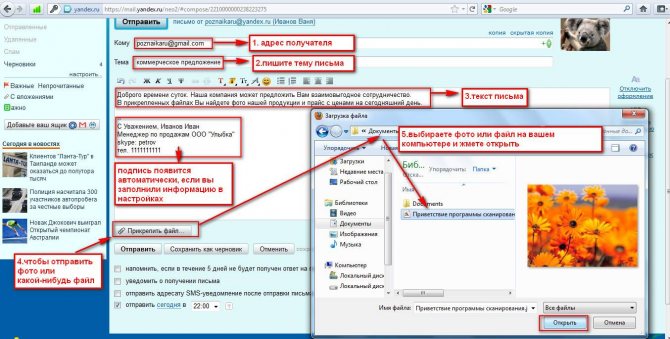
Basic Rules:
- Set up a work email address that you will use in the office.
- The name of the mailbox must contain the appropriate name of either the company or your last name.
- You must always fill in the subject line, otherwise your email risks ending up in spam. In the subject line, indicate the most important information about the letter (no more than 5 words).
- Do not mix several topics in one letter; it is better to divide them into different ones and send them one by one.
- Be polite even online.
- The email should be short, one and a half to two times less than a written letter.
- Attach attachments as separate elements.
- At the end there must be a signature of the company or person sending it.
Structure
This aspect is also of great importance. Composition is important when writing a letter of appeal. The sample is standard. In the upper left corner, put the date of application. On the right - indicate where and to whom the letter should be addressed. This may be the name of a company, institution, government agency, full name of an individual, etc. Just below, write your details: full name, address, telephone, e-mail - the more information, the better. It is advisable to type the text on a computer, and if you decide to write by hand, then be sure to use legible handwriting.
Types of business letters
To decide how to compose a letter, you need to know the differences between its types. This will help you decide on the topic of the message and its correct design.
This will help you avoid looking stupid in the eyes of an important opponent.
According to the design structure there are:
Letters of communication
This includes letters of refusal, claims, excuses, and confessions. Everything that an employee uses in the course of his professional activities.
Letters of agreement
An important type of writing. Thanks to her, the results of the meeting are summed up, agreements are formed, the time for completing tasks is determined, and both parties are convinced of the correct understanding of the contract.
Examples of sentences with appeals
How can I help you, my friend?
Kolya! Shall we go to the cinema today?
Thank you, river, for your coolness in the summer heat!
Write this formula down in your notebook, guys!
You covered the whole city with snow, winter-winter!
Anya! Call me tonight.
My garden! How I love your blooms in spring!
Snow Maiden! Come here and play snowballs with the kids!
Come, grandfather, go fishing with me today!
Which one of you guys can solve this riddle?
Requirements
A business letter must meet the following requirements:
- Speech is standardized at all levels - lexical, morphological and syntactic. It contains many expressions, terms and formulas.
- The tone of writing is neutral, restrained and strict, without the use of emotional and expressive language.
- Accuracy and clarity of the text, without logical errors, clarity and thoughtfulness of wording.
- Conciseness and brevity - without using expressions that carry additional meaning.
- The use of language formulas formed as a result of repeated situations.
- The use of terms, that is, words or phrases that have special concepts.
- The use of abbreviations, which can be lexical (that is, compound words formed by removing letters from parts of words: LLC, GOST, and so on) and graphic (that is, word designations in abbreviated form: grn, zh-d, etc.).
- The use of constructions in the genitive and instrumental cases.
- Phrases with verbal nouns (“provide support” instead of “support”).
- Using simple common sentences.
The above business letter samples are shown in full version (with body) below. The information meets all the requirements of an official business style.
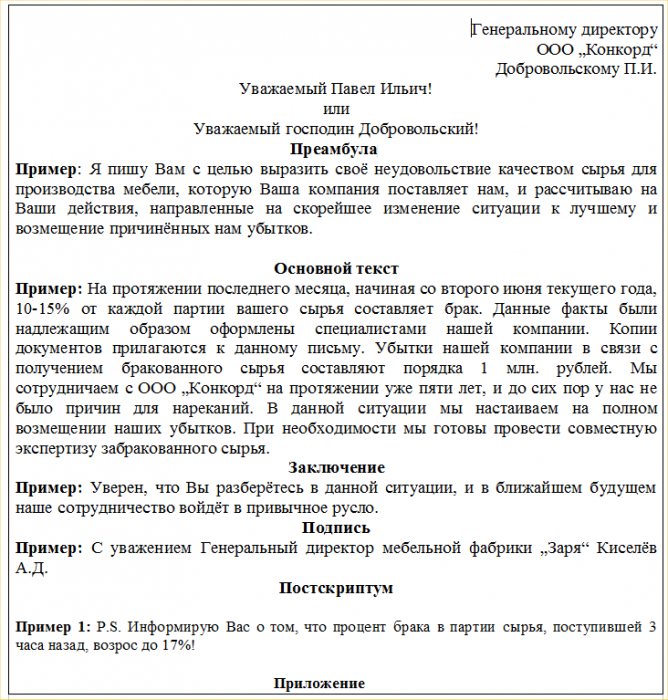
How to write a business letter in English
We found out how to write a business letter in Russian. What about writing letters for foreign companies?
1. Date
In the USA, there is its own form of writing the date: first comes the month, then the date, then the year (October 9, 2021 will look like this - 09/10/19). In Britain, the date is written the same way as in Russia, but it is better to write the month in letters, and not in numbers to avoid confusion.
2. Business letter: recipient details
- Addressing a man looks like this: Mr (followed by the surname).
- Addressing a married woman: Mrs (followed by the surname).
- Addressing an unmarried woman: Miss (followed by the surname).
- If you don’t know the lady’s status: Ms (indicate last name).
3. Recipient's address
For letters sent to the USA, the following order of address writing is established: office number, house number, street name, zip code, state name. Letters sent to the UK must include the name of the county and country.
4. Address to the recipient
Usually this:
- Dear Madam.
- Dear Sir.
- Dear Sir or Madam.
- Dear Mrs.
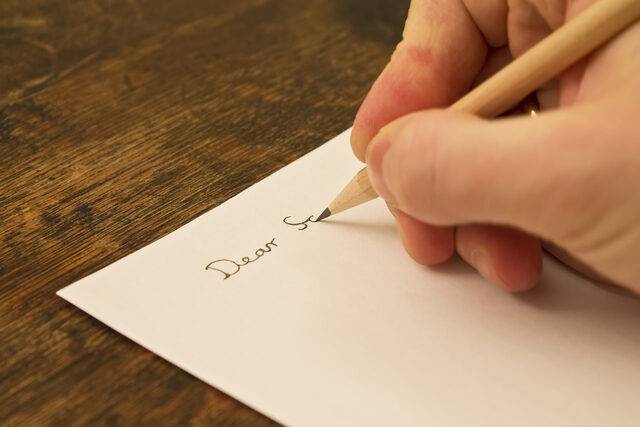
Letters sent to the United States must be followed by a colon. And if the letter is sent to the UK - a comma. The exclamation mark is not used in this case.
5. Subject line
In business letters, you must indicate the subject so that the recipient immediately understands what will be discussed.
6. Text construction
For ease of reading, you need to divide the text into parts and make paragraphs. Sometimes you can write all sentences on a new line.
Read our article “Business ideas for a small town: secrets of search and successful implementation.”
7. Farewell
It must correspond to the style of correspondence; the degree of formality is determined by the general nature of what is written. If you are writing a rather stern business letter, an example of a farewell might be: “Thanking you for assistance, we remain Yours truly...” (Thank you, devoted to you....).
8. Signing
Everything is standard here: after the farewell, the name, surname, position and place of work are indicated, then the signature follows.
9. Application design
If any documents are attached to the letter, “Enc.” must be indicated at the end of it. and list the applications.
10. When are capital letters used?
- Last names and initials.
- Company names.
- Names of cities, states, etc.
- Any words that indicate the position held.
- The first words of farewell.
- Opening addresses.
Drafting a letter of appeal
For most types of appeals, the law defines a free form, including the absence of spelling requirements (this, for example, applies to letters to the prosecutor’s office and the police).
The main condition is that the appeal answer questions about who and where it is sent and what its author wants. In addition, the application must be motivated.
If the appeal is drawn up on the basis of any regulatory act, in fulfillment of any requirement, then it must be mentioned in the text.
In general, the structure of letters of appeal is as follows:
- addressee's name;
- name of the organization, full name, position and address of the applicant, contact phone number or e-mail to which a response can be sent;
- text of the appeal. If the information is confidential and is requested from government agencies, then the status of the originator of the application is indicated (as a rule, copies of supporting documents are attached). As a rule, the appeal in the text of the letter begins with the words “please”;
- list of attachments to the appeal, if any;
- date of sending the letter and signature.
A letter of appeal, the author of which is an organization, is drawn up on the organization’s letterhead.
Common mistakes in business correspondence
There are several seemingly small things that can nevertheless become fatal in the case of business communication. Often it is these little things that lead to the termination of mutually beneficial relationships, the termination of transactions and similar unpleasant things. You need to know the enemy by sight!
- You cannot write (and call too!) about work outside of working hours! How often do we, not wanting to wait until the morning, disturb our partners, clients, colleagues at nine, ten, or even eleven in the evening. It seems to us that everything will disappear overnight, collapse, fail, and it will no longer be possible to save the situation. And those rare individuals who are able to hold out until the morning, for some reason, believe that six in the morning is the best time to communicate. After all, if I don’t sleep, then no one sleeps. Alas, such behavior only irritates and turns us against ourselves.
- This has already been indirectly mentioned, but nevertheless, there can be no familiarity! Communication at work takes place exclusively in “you” (with a capital V, which means politeness and respect).
- Excessive exchange of pleasantries can also cause harm. Firstly, it takes up valuable time, and secondly, it looks a little annoying and boring. No need to try hard.
Business letter etiquette
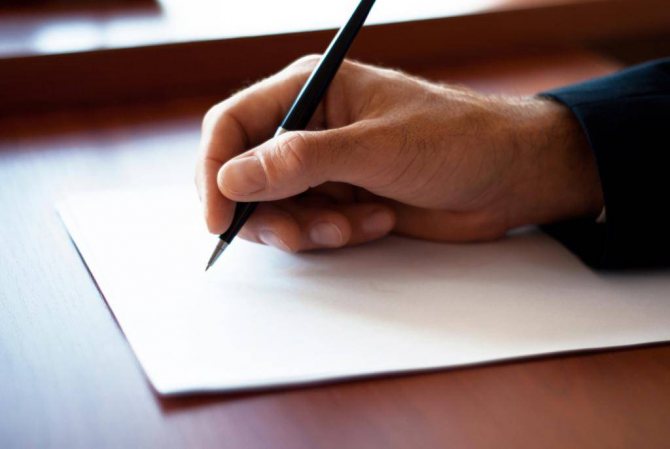
In what cases may we be required to write a business letter? Of course, if we conduct any business with organizations and/or individuals. What we write to our partners, colleagues, clients, the way we format our letter will become the face of our company and present us either in a favorable light or in a not so favorable light. Unless, of course, we are competent in the etiquette of writing business letters. In order not to lose face, you need to learn the wisdom below. By the way, it is also useful to have such knowledge because the slightest mistake, a tiny discrepancy with the rules can turn a business letter into one that is illegal from a legal point of view.
Types of business letters
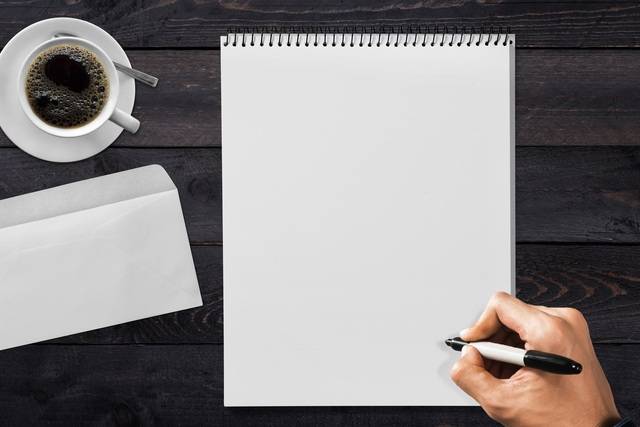
A business letter is a document that performs a number of functions and deals with one or more interrelated issues. Business letters are written for different reasons and have many varieties. Business correspondence is conducted as part of interaction between employees of the same or different enterprises. With its help, you can convey the necessary information to a colleague or partner, make a proposal, make a claim, or ask for something. Such correspondence requires adherence to certain rules and regulations for writing and processing documents.
Any business letter can be classified. The types of such letters are completely different. There are several groups of them, each of which includes letters united by a certain characteristic: topic, function, recipient, composition, form of sending.
Subject:
- Proposal or offer. Offer of goods, services, cooperation.
- Request. Sent in order to clarify the conditions of joint work, some nuances of cooperation.
- Claim. It is sent in case of improper fulfillment of its obligations by one of the parties.
- An information letter is necessary in order to notify the partner about some changes, innovations, etc.
- Confirmation. It is sent in order to inform about agreement with new working conditions or, for example, about the receipt of some kind of shipment.
- Reminder. It is necessary to inform a colleague or partner that, for example, the terms of a contract are expiring.
- Invitation. Sent with the goal of inviting a partner to an event or meeting.
- Congratulations or thank you letter. It is necessary to express gratitude for any reason, in order to congratulate on holidays and significant events.
Function:
- Initiative letters. The sender composes a letter on his own initiative in order to obtain the necessary information, confirm receipt of documents, invite him to a holiday, etc.
- Answers. They are sent in response to initiative letters.
- Letters without answer. Sent to ensure that the partner receives the necessary information. A response to a business letter of this type is not usually written.
Recipient:
- Personal. Sent to the name of a specific person. This could be the head of the enterprise, a department employee, an accountant, etc.
- Group or impersonal. Such letters do not have a specific recipient; they are usually sent to the company's address.
Read our article “Crowdsourcing: everything you wanted to know about it.”
Composition:
- Single-aspect. Such letters are about something specific.
- Multidimensional. These letters have several subjects of discussion.
Departure form:
- Traditional or paper.
- Electronic.
Content of the letter
Next, the same information about the addressee is indicated, with the exception of contact information. The name of the addressee's organization or unit is given in the nominative case, position and surname - in the dative case.
- reason (“due to changes in energy prices…”, “due to production needs”, “due to lack of places in kindergarten”, etc.);
- purpose (“for the safety of cargo passage…”, “to reconcile controversial issues”, etc.);
- link (“based on our telephone conversation”, “considering that production indicators decreased by...”, “based on Government Decree No. __ dated, etc.).
Types of business correspondence
Document circulation is carried out on paper and via e-mail.
All correspondence at the enterprise can be divided into the following groups:
— official/unofficial correspondence;
- internal and external.
Official correspondence includes commercial offers, letters of gratitude and guarantees, trade agreements, orders for the enterprise, job responsibilities, requests, demands, claims.
Informal correspondence includes various congratulations from business partners, customers, and employees; condolences, apologies, invitations and thanks.
Internal documents circulate only between departments of one enterprise, while external documents go beyond its boundaries.
Offer
Any business correspondence (the examples we give also necessarily have this property) requires a logical sequence. If at first you wrote about why you were writing, then you should further specify and expand this idea. Indicate what you would like from the interlocutor more broadly - perhaps draw him the prospect of benefits from agreeing to work with you. This part, by all logic, should be the “peak” of your writing, the culmination of its kind. If initially you smoothly approached what interests you primarily, then in this part you should “reveal your cards.” All business correspondence (the examples of letters above are no exception) should be built along such a smooth upward curve. Then the reader of your lines will understand your mood and, thus, it will be more comfortable for him to communicate with you. Don’t make any abrupt leaps, don’t move from one topic to another.
As the examples show, if you need to discuss, for example, two unrelated issues, you can divide the article into parts by breaking it into paragraphs. This is convenient for both the reader, who will visually see the moment where you move from one question to another; and so it is for you, because in this case you write as if we are talking about two different letters.
If we talk about our examples, we should write: “In addition, we would like to re-order product N, about which we interacted with you a month earlier.” Or: “At a price suitable for our conditions, we would like to establish ongoing cooperation with you in this area, increasing the sales channel to XY thousand units.” Finally, you can do this: “If your interest in working with us is still valid, please let us know.”

Every second sample of business correspondence is built according to this principle, so there is nothing wrong with it. On the contrary, highlighting headings often helps to navigate better, since it removes “solid text” and creates a kind of “anchors” in it that you can visually attach to.
Online Business Etiquette and Business Emails
Electronic letters, like paper ones, consist of several important elements that require competent filling out not at all because of speculative rules, but precisely because these elements can be informative and very convenient from a utilitarian and practical point of view. A correct letter guarantees a correct and prompt response, as well as a constructive solution to the issue.
- Addressee: It is customary to indicate one address in the addressee line.
This indicates not only a respectful attitude towards the interlocutor, but will also protect his e-mail from spam, unnecessary mailings and prying eyes.
- A copy of the addressee's letter is filled out for a specific purpose.
By sending a letter to the main addressee and indicating another in the “copy” section, the addressee informs the second interlocutor about what is happening, but does not require him to respond or directly participate in the correspondence.
- Subject line: specificity and uniqueness.
Extreme specificity of the topic should help both the addressee and the addressee navigate the topic of discussion and distinguish between many problems and tasks: not just “Report from Katya”, but “Report for May 2015. Draft”
Please note: the name in this case is useless, since the addressee is already clear to the addressee from the name of the email box
Emails are equally easy to read on a desktop monitor or a tablet.
- The body of the email should contain 3 key elements.
First, a greeting (if this is the first letter of this day, for example) and an address (in each letter). Secondly, a statement of the question: a presentation of yourself (if the letter is the first), a reminder of the tasks to be solved, a description of the problem or its solution. Thirdly, a request or encouragement to action.
- The email read notification function requires sensitivity.
It should be used if the letter is really important, but there is no way to ask about its receipt by phone, for example. This function usually imposes unclear, vaguely formulated psychological obligations on the recipient, so it should not be abused
A correct and not so categorical option is a polite request at the end of the letter to indicate that it has been read.
- The signature requires conciseness and at the same time capacity.
The wording may contain the standard formula “With respect” or be limited to the last name and first name. The signature, including name, position, organization name and contact information, should not exceed 7 lines. It is advisable to indicate alternative contact information, in addition to your mailbox: telephone, Skype, ICQ, and other popular instant messengers.
- Attachments: the main thing is to warn and name the files correctly.
Netiquette requires information about the document in the file attached to the letter: about the format, its volume and content. The attachment should not be larger than 3-5 Mb. Its title, like the subject of the letter, should be extremely short, specific and unique.
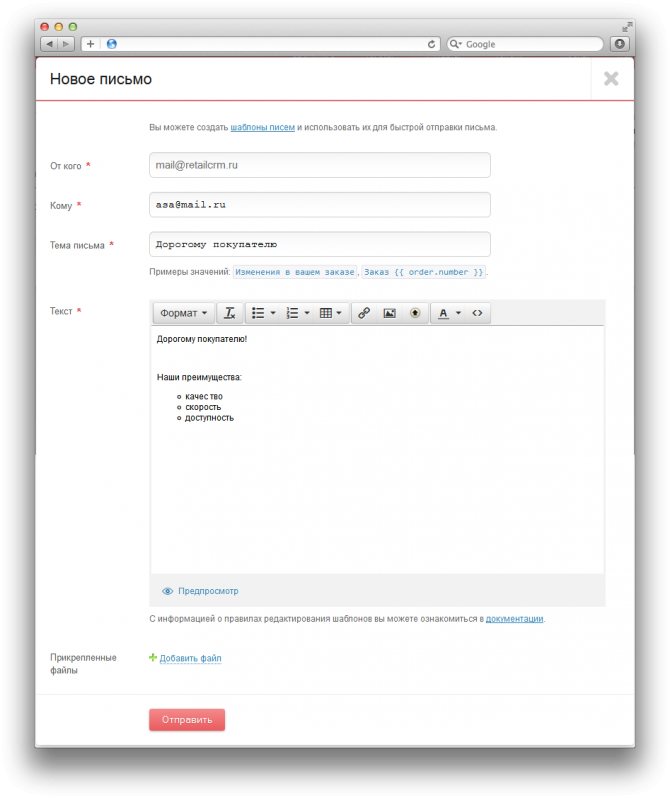
Normal type of email
The reaction time of a letter in netiquette differs from the time in off-line. Two to three hours is a comfortable time to wait for a response to an urgent letter. In response to urgent or important messages, sometimes it is enough to warn that the e-mail has been received and the information has been taken into account. If the problem requires lengthy consideration, then the addressee needs to inform his interlocutor about the time it will take to answer the question.
The reputation of a business person and a company consists not only of the efficiency and effectiveness of the business, but also of the little things and nuances of any stage of business negotiations. Compliance with the principles of business correspondence is required from every representative of the company: from a minor clerk to a public relations specialist and the head of the company.
How to Write a Letter Appeal Sample
The appeal can be sent to two or three authorities at once, putting the appeal in the header.
What usually happens is that it is difficult to identify who is responsible for the function. The organization does not register your appeal or cannot find your appeal. How to deal with such precedents? Here you can seek help from supervisory authorities (Rospotrebnadzor Office, Rostechnadzor, prosecutor's office).
Finding a service that answers your question (read more...)
Nuances
A business letter has its own clear, special structure. At the same time, there is no single standard for the preparation of paper documents: different companies may have their own variations. They adhere only to a certain composition of the parts of the letter: they must certainly contain a “header”, a greeting, the main part and a farewell. Don't forget about your personal signature at the end of the letter.
By the way, the so-called frame of the message - the initial and final phrases - is called a label frame. It is she who helps to establish the necessary relationship with the addressee. In addition, the rules of etiquette for business letters and examples of their writing demonstrate the use of various speech cliches in messages (they will be discussed below).

An important aspect of writing a business letter is the correct use of address. Before the revolution in our country, the address “sir” or “madam” was in use: it was considered universal, they called anyone that way. Nowadays there is no such universal address, although the word “Mr” or “Madam” is often found in business letters - having previously lost its popularity, it is gradually coming back into use. You can address this to a business partner or official, but not to a client or colleague.
The most common and universal at present is considered to be the address “Dear” or “Dear Sir,” but in fact it is not that either. In a similar way, for example, you cannot appeal to the so-called VIPs - especially important persons, who are considered governors, mayors, and presidents. In this case, you will need to start your letter with the address “Dearly” (another option is “Highly Respected”).
If the message is addressed to several people at once, and they are all representatives of the same profession, it would be appropriate to use an address such as “Dear colleagues” (if all addressees are women, it is permissible to write “Dear ladies”; if men, then “Dear gentlemen"). If the letter is addressed to one person, it is strictly forbidden not to use a name or surname. This is permissible only in the above case (when the addressee is a group of persons) or when interacting with a legal entity.
As for the end of the message, you need to remember: it is no less significant than the beginning. It is at the end of the letter that hope is expressed for further cooperation, confidence in a successful and/or quick resolution of the issue, and the like. Here, you should also not point out previous difficulties - for example, delays in answering or failure to receive one at all. These phrases are considered negative signs of business letter etiquette and are considered as reluctance to continue the relationship, as well as disrespect for the interlocutor
It is important to understand that this is unacceptable
Business etiquette: write the right letters!
Author Gulnara Kirpicheva
14.05.2007 09:08
Society » Practice
If you think that the epistolary genre has sunk into oblivion, you are deeply mistaken. In everyday life, you can’t argue, it has become commonplace to make phone calls or exchange instant ICQ messages - simply and quickly. However, in business relationships, letters still play an important role: a telephone conversation, correspondence on ICQ cannot be used to deal with the matter: more serious documents are needed here.
You must be meticulous and responsible when writing business letters. For any business letter, including those sent by e-mail, it is recommended to use letterhead , which indicates the details of the organization. This emphasizes that there is a reputable company behind the letter and you can do business with it. Be sure to indicate the date the letter was written. It is advisable to write the month in letters; abbreviations such as 01/20/02 are accepted only in Russia and are not used in international practice.
A business letter must contain a heading that reveals the content of the text. This makes it much easier for the recipient to process and sort letters. First of all, you need to ensure that your letter is singled out from the mass of similar ones and sent to the right employee. The subject of the letter is underlined or written in capital letters.
The recipient's address is written twice: on the envelope on the bottom right side and in the upper left corner of the letter. If the letter is placed in an envelope with a transparent window, then the address is written once - in the letter, and it is folded so that the recipient's address is in the window. The address is written in the following order: house number, street, name of the city, region, republic (state, county, canton, etc.), postal code, country.
After the address - the initials and surname of the addressee. The initials are preceded by the abbreviations “Mr,” “Ms,” or “G-dam.” If the addressee has a rank or title, it is better to indicate it instead of “Mr.” In all Western European countries and the United States, omitting titles is considered impolite. However, writing and saying “Mr. + title + surname” is accepted only in Germany. In France and England, the addressee's title of nobility is always indicated in the address, but it is not customary to mention it in the body of the letter.
The words “Mr.” and “Mrs.” are not usually used without a surname, and they are always abbreviated to “Mr.” or “Ms.,” while it is advisable to write titles in full. In England, the polite address “Esquire” (Esquire - Esq.) is often written after the addressee’s name, and it is never used in conjunction with the word “Mr.” If you want to send a letter personally, then after the last name indicate: “Personally” (Private - for England, Personal - for the USA).
If the letter is addressed to a company and must be read by a specific person, the expression “Attention of...” is used. You can send a letter to a company address to a person whose address is unknown, and the company in which he works maintains a business relationship with him, indicating “Care of” (C/O).
The opening address traditionally consists of the words “Dear Mr. (Ms.) + last name” or “Dear Mr. (Ms.) + last name.” In official letters, it is not customary to address yourself as “you,” even if you are short in real life. Depending on the degree of closeness with your correspondent, the address may begin with the words “Dear + first name” or “Dear + last name.”
You should not write in your address: “Uv. Mr. Director! In this case, abbreviations are inappropriate. The words “dear”, “sir”, “madam”, “deputy director”, “head of department” and the like should be written in full. Otherwise, the recipient has the right to think that you don’t really respect him very much.
Business letters that contain some kind of compliment . They usually say that they are glad to welcome such a well-known company, that it will be a great honor for you to provide services to such a reputable partner, etc. We can express hope for long-term and mutually beneficial cooperation.
Business letters containing verbal garbage ( “We, of course, are confident that cooperation with us will definitely be beneficial to you
”, excessive politeness (“
Please read this letter, please
”), meaningless adjectives (
outstanding, amazing, wonderful
), unnecessary pronouns (“
we are all glad to cooperate with you and your company
”).
Letters written in this style always give the impression that the author has a low social status. They are rated as less competent and less trustworthy than those with “firmer” writing. Therefore, you should avoid using common phrases, filler words and unnecessary adjectives in every possible way. When writing business letters, you should not use directive phrases (“ you should contact us by phone...
").
With such a phrase you psychologically turn people against you. You should not arrogantly tell your partners how they should behave. It is better to write: “ To discuss the details of our offer, you can contact us by phone....
” The meaning is the same, but the tone of the letter encourages a more friendly attitude towards you.
When describing the activities of your company, pay attention to the choice of verbs . Perfective verbs talk about real results: completed, developed, increased, created, made, etc. Imperfective verbs create more indefinite ones in relation to the result of an activity: we produce, we work, we perform, we participate. They provide insight into the functions performed rather than the results achieved. The use of perfect verbs will create the impression of concrete success, and therefore will create the impression of solidity and respectability of your company. In the letter of request , if possible, briefly indicate the reason, formulate the request itself clearly, and thank in advance for fulfillment. Notification letters are written as a token of gratitude for the response, as an expression of readiness to cooperate, or as an information message . Under such a letter it is enough to put the signature of the referent.
A reminder letter is sent in cases where telephone conversations or personal contact fail to achieve the desired result. The purpose of such a letter is to tactfully remind you of the need to fulfill your obligations.
A confirmation letter is a guarantee of previously made promises or terms already agreed upon. Such a letter is an expression of politeness and respect for the partner. The letter of claim must contain the claim itself, the basis for its presentation and specific requirements.
In response to a claim, refusal letters . It is better to start and end such a letter with positive information: for example, listing what you agree with, then explaining the reason for the refusal. The letter will help, despite the refusal, to maintain a normal relationship with a client or partner.
An apology letter usually contains a statement of the reasons why the prior agreement was suddenly broken. In some cases, such a letter is sent after notification by telephone. A letter of guarantee is sent as an obligation to pay for something, indicating the type of operation to be performed. The letter ends with the phrase “We guarantee payment” and indicating your bank details and has two signatures - the manager and the chief accountant.
congratulations, thanks, and condolences by hand to emphasize a sincere and individual attitude towards your partner.
A letter containing a serious business proposal , involving mutual monetary settlements for a substantial amount, is better to be sent by mail, rather than by fax or e-mail. Ideally, the postal courier should hand it over personally to the manager or secretary. Such a letter must have a large branded envelope, printed in a typographical manner.
A business letter must contain a final politeness formula : “With respect,” “With respect.” In an official letter abroad, as a rule, Very truly yours (“Sincerely yours”) is used. Moreover, in the response letter it is advisable to use the same politeness formula as in the received one.
As you can see, everything is very simple, although there are more than enough conventions. Write letters!
Curator: Natalia Krasovskaya
Topics road
Working with attachments
If there is too much information to convey, do not put it all in the body of the letter, but attach it as separate documents as attachments.
For the convenience of the recipient, rename the documents you prepared to names that he understands. This will show your interest and win you over. Think about how many work folders the recipient has on his computer and how he will search for your letter among them.

Be sure to inform the recipient about the files you are sending so that he does not consider them a random virus. Archive large documents.
It is best to send too large attachments (over 200 kbytes) in other ways, for example, through an ftp server.
Some mail servers do not allow formats such as COM, EXE, CMD, PIF and a number of others to pass through and block them.
If there were several recipients of your letter, take the time to delete all evidence of mass forwarding each time. The addressee does not need such extra information at all. The “bcc” command will help you.
The rules for conducting business correspondence by e-mail require informing the other party that the correspondence has been received. If it is not possible to answer at the moment, notify your interlocutor about this. Save your correspondence history to avoid further questions and proceedings.
If the response is important and urgent, it is allowed to additionally notify the addressee by phone, Skype or ICQ. If after this it was not possible to achieve a positive result, remind yourself again
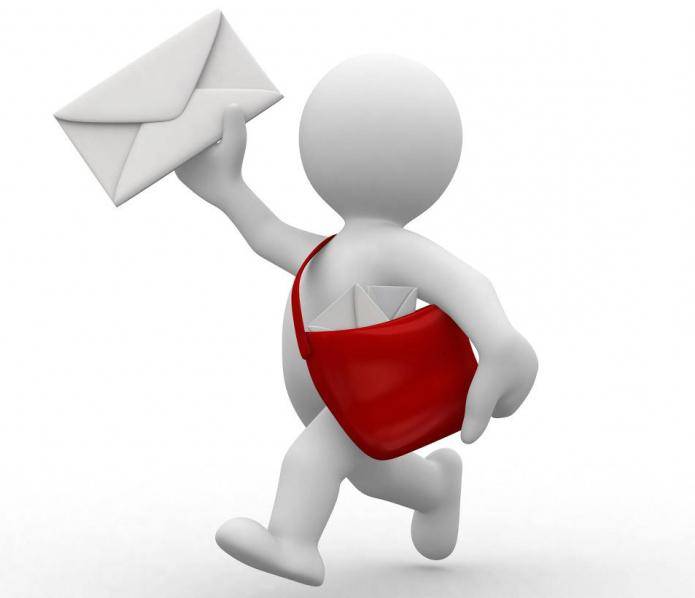
It is not uncommon that when you request a document, you receive an empty letter with an attached file in response. It is unacceptable. Examples of business correspondence require that relevant information be placed in the body of the document. For example, this: “I am sending the necessary data for your request.”
Don’t forget to indicate the coordinates at the end of the letter: all available methods of communication, position, company website, links to social networks.
When writing organization contacts, provide as much information as possible - telephone number with area code, address with zip code. After all, your communication occurs not only with residents of your region. If you have all the information, it will be easier to contact you.
And the last rule: whoever started the correspondence must finish the electronic dialogue.
How to deliver a letter to the addressee
You can send official letters in different ways:
- The simplest, fastest and most accessible: electronic means of communication . The only disadvantage of this route is that the message can easily get lost, ending up, for example, in the spam folder. Therefore, this option is only suitable in cases where the sender already has direct contact with the recipient (through personal meetings or telephone communication).
- The second method, also in demand, is more reliable, but time-consuming: sending an official letter via Russian Post by registered mail with return receipt requested. This method guarantees the receipt of the letter by the addressee, as does another classic method that has not lost its relevance to this day: sending a message via fax.
Source of the article: https://assistentus.ru/forma/oficialnoe-pismo/
Business communication style
Business correspondence involves a delicate balancing act. Friendly communication is inappropriate here, but emphatically harsh communication is not appropriate either.
Features of communication:
Severity of designs
Diminutive words and slang expressions will be inappropriate.
Using emoticons
Use emoticons carefully or avoid them. The first contact does not allow their presence in principle
In the future, brackets may be present, but only positive ones, in moderate quantities. Niceness and humor are unacceptable in this style of communication. This form is unacceptable if you are subordinate to your interlocutor.
Greetings by name and patronymic
The rules for conducting business correspondence imply a respectful attitude towards the interlocutor, attention and interest in his person. This increases your opponent's interest in you and increases the chance of his leniency.
It is advisable to know in advance the name of the person you are addressing, as well as his preferences for address.
Reply within two days
It is correct to send a response to the message within a few business days. Otherwise it is considered disrespectful. If the letter was sent before the weekend or vacation, you don’t have to respond to it if it’s not urgent. Otherwise, you need to warn your interlocutor about the temporary absence of your response or briefly unsubscribe about the contents of the letter.
Lack of intrusiveness
Constantly asking about something, asking for confirmation will show you in a bad light. If confirmation from the interlocutor is required, you can remind him of the need to respond in three days. If the matter is urgent, it is better to mention it initially in your first message.
Mirror rule
Business correspondence etiquette often allows you to address your opponent the way he does. This increases the possibility of mutual understanding and communication on the same level. Keep track of what terms, style of communication, and address your interlocutor uses.
Happy holidays
If communication takes place around or during official holidays, it is worth congratulating the interlocutor. These are the rules of business correspondence. It is also useful to know when your opponent's birthday is.
Gratitude
Elementary politeness would be words of gratitude in response to a congratulation, invitation, or explanation.
Taking into account all the above features, it will not be difficult to establish contact with your interlocutor and form a favorable opinion about yourself.
Etiquette in written business communication
In written business communication, etiquette is manifested in the form and content of documents:
- Argument format.
- Methods of treatment.
- Ways of expressing requests, refusals, claims.
They help achieve the communication goal. at the same time demonstrating the level of culture of the author of the message.
In business correspondence, the use of etiquette and formulas is regulated. The first formula for demonstrating etiquette is to appeal to the addressee’s personality to establish contact and attract attention.
Appeal is an important part of commercial correspondence. Now it is also used in official correspondence, when you need to contact an official directly.
Basic rules for correspondence by e-mail
Use your work email address only for its intended purpose.
Pay attention to the name of the mailbox. Do not use incorrect names when working, such as “baby”, “superman”, even if they are indicated in English transcription

Always fill in the “subject” column, otherwise your letter may end up in spam. Descriptions like “plan”, “list”, “commercial proposal”, “report” will not work. There may be quite a lot of similar letters in your recipient's inbox. Be as specific as possible about what your message is about. Don't use more than five words. Capitalize your subject. There is no need to put a period at the end.
If you are replying to a previously received email, be sure to remove the “Re” in the subject line.
How to conduct business correspondence correctly
When composing a letter, it is important to pay attention to all details. When describing the rules of business correspondence, it is worth paying attention to the following aspects:
If you are writing a letter in which you need to answer specific questions asked by the author, then it would be appropriate to quote each of them separately. To do this, use numbering and break the text into paragraphs. When composing a letter, you need to briefly comment on all the documents attached either by you or the interlocutor
This is important so that the recipient immediately understands the essence of the letter. The letter must be signed by the manager and stamped.
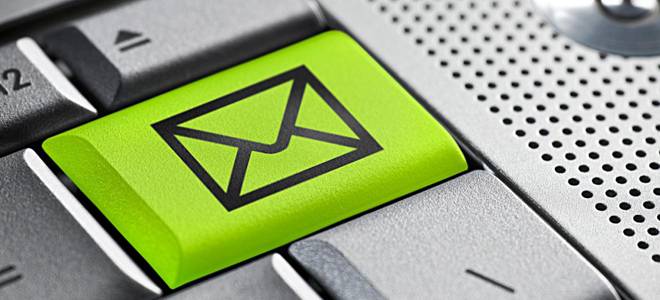
Rules for conducting business correspondence
Errors when composing business letters are unacceptable, so it is important to know the basic rules for composing them:
- Do not use words whose meaning is unknown, or check their interpretation using a dictionary.
- Conducting business correspondence excludes the use of specific terminology, since some words may be unknown to the addressee. If such terms are used, then provide an explanation.
- Express your thoughts in short sentences so that the main point is not lost.
- If you don’t know the Russian language thoroughly, then it’s better to first type the text in an editor or in a document on your computer to check your spelling.
- Business correspondence does not allow the use of colloquial words, literary expressions, and so on. Before sending a letter, check it for errors and typos. It is better to check again after a while.
Beginning of a letter in business correspondence
First, in the structure of the letter there is a “header”, which contains the position and full name of the addressee. Features of business correspondence include the standard address “Dear,” which in most cases is written in the center of the page. If the person is unfamiliar, then the word “Mr.” is written before the last name. The first paragraph (preamble) includes the purpose and reason for the letter. After reading it, the addressee should understand the main meaning of the message.
Request in business correspondence
One of the popular types of business correspondence is a request letter. This could be a tactful request or a diplomatic demand on a current issue. Business writing skills are important for writing requests because they should motivate the recipient to take the action required by the writer. There are certain rules for writing a letter:
- The addressee should be addressed personally, observing the basics of business etiquette.
- To explain to the recipient the reason for the request, you can give him a compliment, highlight his business or personal qualities and merits.
- Give reasons for the request and interest the addressee in fulfilling it. The problem should be described as concisely and clearly as possible.
- Once the request is made, it should be modified and repeated again, emphasizing the potential benefits.
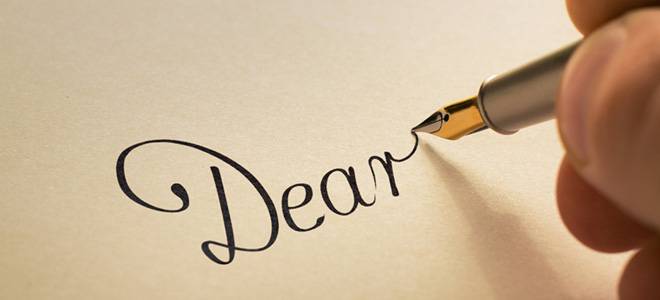
How to remind yourself in business correspondence?
A reminder letter is used when you need to remind about the fulfillment of undertaken obligations, compliance with the law, the approach of an important event, and so on. In most cases, a verbal reminder is used before it
As a result, the letter serves as some kind of evidence of the action taken. A reminder in business correspondence includes:
- Information about the sender and recipient. After this, the reason for the reminder is stated.
- Links to laws and regulations related to the issue being recalled are provided.
- The phrases of business correspondence should be clear, but not threatening. It would not be amiss to remind you that the problem can be solved peacefully.
- The letter has no standards, so it can be written in free form.
How to properly apologize in business correspondence?
One of the most difficult letters to write is an apology letter, which requires you to both apologize and save face for the company. In addition, it is aimed at restoring damaged relationships. Business correspondence indicates the following features of the apology:
- The structure of the letter includes the indication of the recipient, the subject of the message and the message.
- You don’t have to specify the performer, since management will sign everything.
- Phrases of apology in business correspondence should not be explicit and the subject of the letter should be neutral or absent altogether.
- The effect that needs to be achieved is a sincere apology and information about what happened, that is, an indication of the reason for the unpleasant situation.
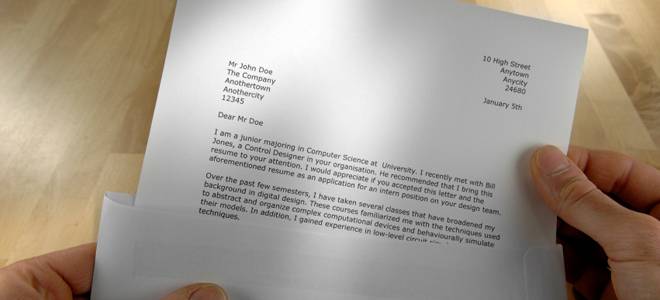
How to Write a Letter Appeal Sample
An example of a well-written address to the president. The letter briefly and clearly explains the reason for the appeal, which sounds quite convincing. Then comes the request itself (help for the museum), and then the sender uses an effective technique. He recalls the Decree issued shortly before, focusing on the urgency of the problem.
- How to write an appeal in a letter sample
- How to properly format an appeal in a letter
- How to properly fill out an application sample
A letter of request cannot be unified and written according to a standard template. However, it is an official document and requires compliance with the rules of business correspondence. Grammatical, syntax, punctuation errors, corrections and erasures are unacceptable.
Private recommendations (read more...)
